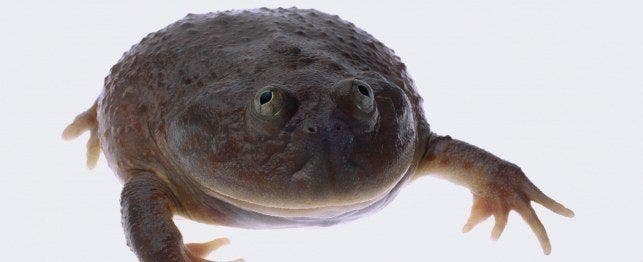
Choosing a Budgett’s Frog
The Budgett’s frog, also known as the “Freddie Kruger” frog, is an easy to maintain aquatic frog, related to the ornate horned frog. A member of the Leptodactylidae family, the Budgett’s frog is not an agile jumper but is quite an agile swimmer.
History and Origin
The Budgett’s frog is admirably adapted to life in seasonally semi-arid regions. As the ponds dry, the Budgett’s frog burrows well down into the mud, secretes a cocoon around itself and becomes dormant until roused again by the rains.
Captive-bred Budgett’s frogs are usually readily available and can live for more than 5 years.
These frogs should be kept singly. A 5-gallon aquarium containing several inches of water and either floating or rooted plants will suffice.
Appearance
Both the hatchlings and the adults of this strange little frog are grumpy-appearing, heavy bodied, and very big headed. The ground color of both baby and adult is olive-green dorsally and laterally. There is a camouflage pattern of tans and darker greens, and the eyelids are often a brighter green. The adult male has a dark throat; the throat of the female is white or grayish. The pupils are of a characteristic diamond-shape.
Behavior
Predaceous and voracious best describes this aquatic frog. They will eat, or try to eat, nearly anything that they can overpower. Budgett’s frogs are quite temperature and moisture tolerant. Room temperature (72 to 84 degrees Fahrenheit) seems to be a perfectly acceptable temperature range for these frogs.
Unless prodded or otherwise provoked, these are slow moving, almost lethargic, frogs. Most are not at all reluctant to bite the hand that feeds them. Use care when ministering to the needs of these large frogs.
When taken from the water and placed in moist terrestrial conditions, Budgett’s frogs are adept at burrowing. If terrarium conditions permit, these frogs may sit with only their head exposed, or they may burrow completely from sight. Those kept in a bare aquarium, with only a few inches of clean water, seem to fare equally as well as those kept in semi-aquatic conditions. Terrarium cleanliness is essential to good health and long life for these frogs.
Feeding
The diet of wild Budgett’s frogs includes insects, crustaceans, tadpoles, minnows, snails, worms, frogs, small snakes, lizards, and an occasional small rodent. Captives eat earthworms, crickets, freshly killed minnows, and a very occasional pre-killed pinkie mouse. The pre-killed items should be offered from forceps. They can and will bite their human keeper. The strong jaws are equipped with sharp tooth-like processes, and a bite, though not dangerous, can leave a lasting impression.
Fast growing baby Budgett’s frogs need considerable calcium. Insufficient calcium can also result in MBD. Monitor your fast growing frogs carefully.
Handling
If you must handle your Budgett’s frog, wash your hands both before and after. The frog’s permeable skin will absorb any impurities from your hands, and the residue of many items that humans occasionally have on their skin– perfumes, cleaning agents, sunscreen, insecticides– can be injurious or fatal to your frog.
These frogs are best lifted in a net (cover the net with your hand so the frog can’t jump from the net and injure itself) or, if necessary, by grasping them firmly around the waist with your hand. Handle your frog gently and sparingly and don’t get bitten in the process.
Housing
These medium-sized frogs are quiet and do not require a great amount of space to survive– even thrive– in captivity. Because they are very predaceous, they should be kept singly.
A metamorph can be kept in a terrarium of only the size of a plastic shoebox. An adult will need at least a 10-gallon tank. The tank may be simple in the extreme– bare except for a little clean, chemical-free, water, and gently sloped to keep that water on the low end.
Budgett’s frogs will also thrive in a filtered aquarium containing several inches of water and having a profusion of rooted and floating plants. Since frogs quickly absorb impurities through their skin, it is imperative that the water and/or the substrate always be kept immaculately clean. The best terrarium temperature range for this frog is in the mid-70s to mid-80s.
Common Diseases and Disorders
- Metabolic bone disease may be caused by an inability to metabolize calcium or insufficient dietary calcium.
- Redleg (Aeromonas, etc. infections) is caused by poor water quality or inadequately cleaned substrate.
- Absorption of insecticides through the skin can be almost immediately fatal to this frog, or to any other amphibian. Wash and rinse your hands before and after handling your Budgett’s frog.